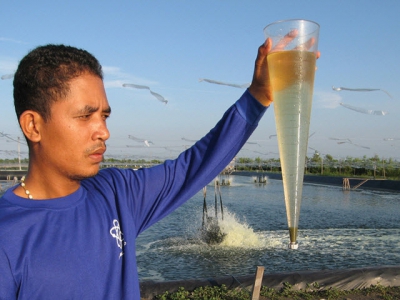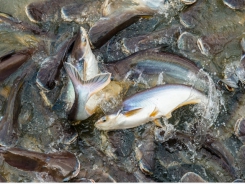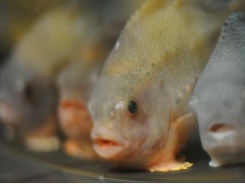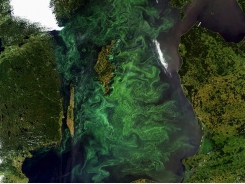Recent developments in biofloc technology

Biosecure systems improve economics, sustainability
Bioflocs are conglomerates of microbes, algae and protozoa together with detritus and dead organic particles.
This production unit uses lined reservoirs, culture ponds and discharge canals at a sustainable shrimp farm in Malaysia.
Biofloc technology has become popular in the farming of Pacific white shrimp (Litopenaeus vannamei). The basic technology was developed by Professor Yoram Avnimelech in Israel and initially implemented in commercial shrimp culture in Belize by Robins McIntosh. It also has been applied with success at shrimp farms in Indonesia and Malaysia by the author.
The combination of two technologies, partial harvesting and biofloc, has been studied in northern Sumatra, Indonesia. The system has also been successfully incorporated with biosecure modular culture system. This latter combination can make operations much more sustainable and economically viable.
Farm evolution
For sustainable shrimp farming, biosecurity is a major factor. Farm biosecurity begins with the design and construction of the farm.
During the late 1980s, most shrimp farms in Asia were designed with flow-through water systems. The best example was the huge Dipasena farm in Lampung, Indonesia, where rows of ponds were served by supply and discharge canals at opposite sides. The system worked well until the appearance of bacterial outbreaks in the early 1990s. Reservoirs were added to manage and control the bacteria problems.
C.P. Indonesia designed a large shrimp farm with recirculating water systems, reservoirs and sedimentation ponds to address the bacteria. However, during the mid-1990s, viral problems developed, especially white spot syndrome. Again, farm designs needed to change to enable treatment of incoming water before its use in culture ponds.
A more recent modular design used by Blue Archipelago Berhad in Malaysia consists of two units of four reservoir ponds, which is approximately 20 percent of the culture pond area. There is only one entry point for raw water, which has to pass through the four reservoir ponds before reaching the module’s main supply canal. From the main canal, treated water is distributed to the culture ponds.
Biofloc system
For optimized, sustainable commercial biofloc shrimp culture, high-density polyethylene- or concrete-lined ponds are basic requirements. High stocking densities of 130-150 postlarvae/m2 and high aeration rates of 28-32 hp/ha are also essential. Paddlewheel aerators are placed in ponds to keep dissolved-oxygen levels high and guide sludge toward the central areas of ponds. The sludge can then be siphoned out periodically when needed.
Bioflocs are conglomerates of microbes, algae and protozoa together with detritus and dead organic particles. The aerators help suspend the bioflocs in the pond water – a main requirement for maximizing the potential of microbial processes in shrimp culture ponds. The suspended biofloc is also readily available as feed for shrimp.
Pelleted grain and molasses are used to sustain carbon:nitrogen ratios above 15. In addition to typical chemicals such as dolomite and lime, kaolin is required in the preparation of pond water and during operation. Kaolin is applied at 50-100 kg/ha once or twice a week.
Operation, control
Only treated water should be used. Generally, incoming water is screened using 250-μ nets to prevent larval crustaceans (especially crabs) from entering reservoirs and culture ponds. The water is treated with crustacides to eradicate any remaining crustaceans and their eggs. At the same time, the water will have been aged at least 74 hours within the reservoirs or culture ponds. This aging process eliminates any viral particles in the water.
The most important factor is to make sure the screening, chemical treatment and aging process are efficiently used before stocking ponds with shrimp. Only specific pathogen-free postlarvae should be stocked.
Once ponds are stocked, a major factor to control is biofloc volume. Using Imhoff cones for assessment, biofloc volumes need to be maintained below 15 ml/L. At least two samples need to be taken concurrently from two locations below the water surface. Green or brown water is acceptable, but black water is an indicator of abnormal conditions.
Grain pellets and molasses supply sources of carbon as needed. Generally, grain pellet applications vary from 15 to 20 percent of the total feed used during operations. Molasses can be applied two or three times weekly at 15-20 kg/ha/pond. Dissolved oxygen needs to be monitored as frequently as possible to keep levels higher than 4 mg/L. Especially in biofloc systems, aerators need to be constantly monitored for malfunctions and repaired or replaced without delay.
Culture performance
A comparison of the expected culture performance of the biofloc system to a traditional autotrophic system is shown in Table 1. Shrimp grow faster and yield a larger harvest in biofloc systems. Feed conversion is better with biofloc, so feed costs are lower.
| Biofloc System | Autotrophic System | |
| Production (mt/ha) | 22 | 21 |
| Feed-conversion ratio | 1.1-1.3 | 1.5-1.7 |
| Culture period (days) | 90-100 | 110-120 |
| Energy efficiency (kg/hp) | 680-1100 | 400-600 |
| Water exchange | Zero | Minimum to flow-through |
| Shrimp color (salmon scale) | Over 28 | Under 24 |
| Gross profit (%) | Over 35 | Under 30 |
Table 1. Comparison of biofloc, autrophic production systems.
Less water is exchanged with biofloc technology, and the pond systems are more stable than in autotrophic culture. Greater output with bioflocs also improves energy use.
Other applications
In addition to intensive fish and shrimp culture, biofloc technology has been applied in super-intensive raceways to produce over 9 kg shrimp/m3. The raceway applications have supported nursery, grow-out and shrimp broodstock operations, as well as selection of family lines.
Presently, studies by several major universities and private companies are using biofloc as a single-cell protein source for aquafeeds. According to some authors, biofloc’s crude protein content ranges 35.0 to 50.0 percent, and its crude lipids represent 0.6-12.0 percent of volume. Biofloc can be slightly deficient in arginine, lysine and methionine. Its measured ash content ranges between 21 and 32 percent.
Perspectives
In any aquaculture business, savings from efficient use of feed, time, energy, system stability and sustainability can improve profits. It seems biofloc technology has these properties. With emerging viral problems and rising costs for energy, biofloc technology with biosecure modular systems may be an answer for more efficient, sustainable, profitable aquaculture production.
Related news
Tools

Phối trộn thức ăn chăn nuôi

Pha dung dịch thủy canh

Định mức cho tôm ăn

Phối trộn phân bón NPK

Xác định tỷ lệ tôm sống

Chuyển đổi đơn vị phân bón

Xác định công suất sục khí

Chuyển đổi đơn vị tôm

Tính diện tích nhà kính

Tính thể tích ao




 Pellet-based oral vaccine holds promise for VNN protection
Pellet-based oral vaccine holds promise for VNN protection  Fish farm management goes into orbit
Fish farm management goes into orbit